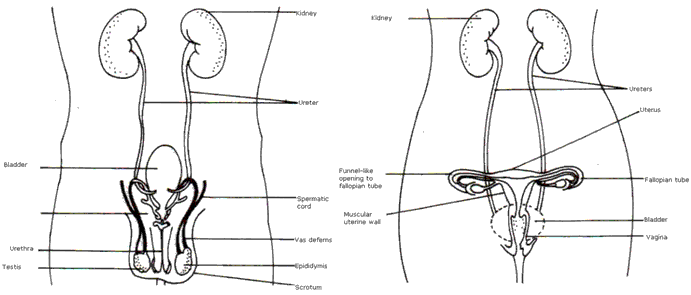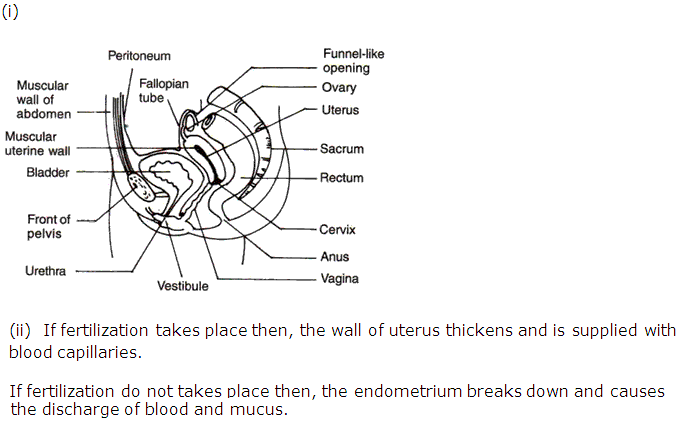Class 10 FRANK Solutions Biology Chapter 11 - Reproductive System
Get 24/7 access to Frank Solutions for ICSE Class 10 Biology Chapter 11 Reproductive System at the TopperLearning study portal. You can learn more about human reproduction and revise concepts like fertilisation, parthenogenesis, gestation, ovulation, implantation etc. with our well-written Frank Solutions.
Learn to correctly label the reproductive parts with our ICSE Class 10 Biology textbook solutions for this chapter. Also, practise with our solutions to understand the types of questions asked on the female reproductive system. For more learning support, explore our chapter videos, practice tests, question papers and more.
141
142
143
Reproductive System Exercise 141
Solution 1
(i) Testes
(ii) Ovary
(iii) Uterus
(iv) Oviduct
(v) Fertilization
(vi) Parthenogenesis
(vii) Testes and ovaries
(ii) Ovary
(iii) Uterus
(iv) Oviduct
(v) Fertilization
(vi) Parthenogenesis
(vii) Testes and ovaries
Solution 2
(i) penis
(ii) vagina
(iii) oviduct
(iv) female
(v) oviduct
(ii) vagina
(iii) oviduct
(iv) female
(v) oviduct
Solution 3
(i) Ovary: To produce ova and three female sex hormones i.e oestrogen, progesterone and relaxin.
(ii) Fallopian tube: To transport eggs from ovary to uterus and it a site of fertilization.
(iii) Uterus: To protect and provide nutrients for the developing embryo.
(iv) Vagina: To receive the seminal fluid.
(v) Testes: To produce sperms and male sex hormone i.e. testosterone.
(vi) Penis: deposition of semen into the female's vagina.
(ii) Fallopian tube: To transport eggs from ovary to uterus and it a site of fertilization.
(iii) Uterus: To protect and provide nutrients for the developing embryo.
(iv) Vagina: To receive the seminal fluid.
(v) Testes: To produce sperms and male sex hormone i.e. testosterone.
(vi) Penis: deposition of semen into the female's vagina.
Solution 4
(i) Parthenogenesis: It is a type of asexual reproduction in which a female gamete or egg cell develops into an individual without fertilization.
(ii) Asexual reproduction: It is the type of reproduction in which the offspring are formed without the production of gametes.
(iii) Sexual reproduction: It is the type of reproduction in which the offspring are formed after the fusion of gametes.
(iv) Dioceious: It is the individual / organism having male and female reproductive organs in separate individuals.
(v) Monoecious: It is the individual / organism having male and female reproductive organs in the same individual.
(vi) Clone: It is a group of genetically identical cells or organisms asexually descended from a common ancestor.
(ii) Asexual reproduction: It is the type of reproduction in which the offspring are formed without the production of gametes.
(iii) Sexual reproduction: It is the type of reproduction in which the offspring are formed after the fusion of gametes.
(iv) Dioceious: It is the individual / organism having male and female reproductive organs in separate individuals.
(v) Monoecious: It is the individual / organism having male and female reproductive organs in the same individual.
(vi) Clone: It is a group of genetically identical cells or organisms asexually descended from a common ancestor.
Solution 5
(i) Parturition: The expulsion of the foetus from the mother's body is called parturition.
(ii) Ovulation: The process of release of an egg from the ovary is called ovulation.
(iii) Spermatogenesis: The production and development of sperms is called spermatogenesis.
(iv) Gestation: The period in which an embryo develops in the uterus is called gestation.
(v) Implantation: The attachment of developing zygote to the uterine wall is called implantation.
(ii) Ovulation: The process of release of an egg from the ovary is called ovulation.
(iii) Spermatogenesis: The production and development of sperms is called spermatogenesis.
(iv) Gestation: The period in which an embryo develops in the uterus is called gestation.
(v) Implantation: The attachment of developing zygote to the uterine wall is called implantation.
Solution 6

Reproductive System Exercise 142
Solution 7
(i) Graafian follicle
(ii) Uterus
(iii) Ovulation is the process of releasing of egg from the ovary.
(iv) The hormones secreted by the ovary are: oestrogen and progesterone.
(ii) Uterus
(iii) Ovulation is the process of releasing of egg from the ovary.
(iv) The hormones secreted by the ovary are: oestrogen and progesterone.
Solution 8
(i) 1. Peritoneum
2. Ureter
3. Backbone
4. Rectum
5. Seminal vesicle
6. Glands
7. Anus
8. Vas deferens
9. Epididymis
10. Left testis
11. Scrotum
12. Penis
13. Urethra
14. Vascular erectile tissue
15. Bladder
16. Muscular wall of abdomen
(ii) The two functions of part 6 are :
(a) Prostate gland secretes an alkaline milky secretion into semen that aids in sperm motility.
(b) Cowper's gland also secretes a lubricant.
(iii) The three components of urine are urea, uric acid, amino acids, glucose, sodium, potassium, vitamins etc.
(iv) The main function of the part labelled 3 is backbone. Its function is to give support, movement and protection to the spinal cord.
2. Ureter
3. Backbone
4. Rectum
5. Seminal vesicle
6. Glands
7. Anus
8. Vas deferens
9. Epididymis
10. Left testis
11. Scrotum
12. Penis
13. Urethra
14. Vascular erectile tissue
15. Bladder
16. Muscular wall of abdomen
(ii) The two functions of part 6 are :
(a) Prostate gland secretes an alkaline milky secretion into semen that aids in sperm motility.
(b) Cowper's gland also secretes a lubricant.
(iii) The three components of urine are urea, uric acid, amino acids, glucose, sodium, potassium, vitamins etc.
(iv) The main function of the part labelled 3 is backbone. Its function is to give support, movement and protection to the spinal cord.
Solution 9

Solution 10
(i) Graafian follicle
(ii) Seminal vesicles and prostate gland
(iii) Uterus
(iv) Parturition
(v) Oviduct
(ii) Seminal vesicles and prostate gland
(iii) Uterus
(iv) Parturition
(v) Oviduct
Reproductive System Exercise 143
Solution 11
(i) 1. Fallopian tube
2. Funnel like opening
3. Ovary
4. Uterus
5. Sacrum
6. Rectum
7. Cervix
8. Anus
9. Vagina
10. Front of pelvis
11. Bladder
12. Muscular uterine wall
13. Muscular wall of abdomen
14. Peritoneum
(ii) Normally, after 28 days an ovary releases an egg.
(iii) During coitus, sperm are released in the vagina.
(iv) After ejaculation in vagina, sperms undergo fertilization where it fuses with an ovum of female to form zygote.
(v) The function of sacrum is to protect the pelvic organs or reproductive organs of female.
(vi) The gestation period in human is 280 days.
2. Funnel like opening
3. Ovary
4. Uterus
5. Sacrum
6. Rectum
7. Cervix
8. Anus
9. Vagina
10. Front of pelvis
11. Bladder
12. Muscular uterine wall
13. Muscular wall of abdomen
14. Peritoneum
(ii) Normally, after 28 days an ovary releases an egg.
(iii) During coitus, sperm are released in the vagina.
(iv) After ejaculation in vagina, sperms undergo fertilization where it fuses with an ovum of female to form zygote.
(v) The function of sacrum is to protect the pelvic organs or reproductive organs of female.
(vi) The gestation period in human is 280 days.
Solution 12
(i) False
(ii) False
(iii) True
(iv) False
(v) True
(ii) False
(iii) True
(iv) False
(v) True
Solution 13
False.
Pregnancy in women can be prevented by the method of tubectomy.
Pregnancy in women can be prevented by the method of tubectomy.
Solution 14
Amnion.
Solution 15
(i) Menarche
(ii) Ovulation
(iii) Menstruation
(iv) Fertilization
(v) Implantation
(ii) Ovulation
(iii) Menstruation
(iv) Fertilization
(v) Implantation
Solution 16
(i) (b) continuity of race
(ii) (b) asexual reproduction
(iii) (b) female gamete
(iv) (c) Parthenogenesis
(v) (b) vagina
(vi) (c ) castration
(vii) (b) oviduct
(viii) (c ) puberty
(ix) (b) menarche
(x) (c ) 20-30C below the body temperature
(xi) (d) menarche
(xii) (b) 10 days
(ii) (b) asexual reproduction
(iii) (b) female gamete
(iv) (c) Parthenogenesis
(v) (b) vagina
(vi) (c ) castration
(vii) (b) oviduct
(viii) (c ) puberty
(ix) (b) menarche
(x) (c ) 20-30C below the body temperature
(xi) (d) menarche
(xii) (b) 10 days

